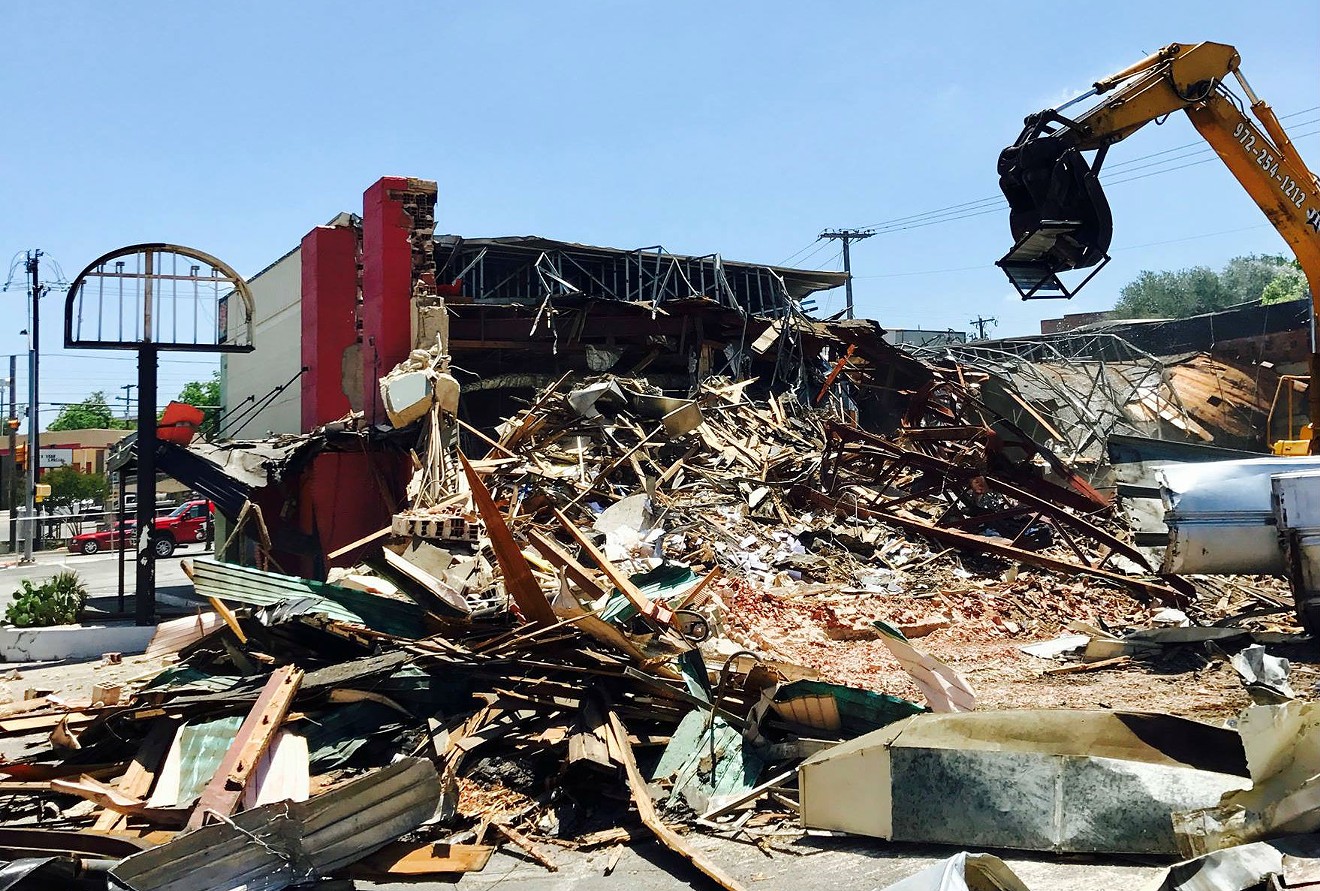Anderson redeveloped the historic Belmont Hotel in Oak Cliff, opting to keep its small footprint and historic appeal.
“The big developers are like vultures coming in when the eating’s good," he said. "You’re not going to beat them. If you wait until the market is here, like in North Oak Cliff, forget it.”
Anderson was speaking on a panel in the Arts Mission building in Oak Cliff on Tuesday evening. The panel, sponsored by Old Oak Cliff Conservation League, was brought together to discuss ways of better protecting Oak Cliff’s historic gems — buildings like the one that housed the Tex-Mex restaurant El Corazon, which was recently demolished.
Now the building, originally designed as a supermarket in the 1940s in the Streamline Moderne style, is a flattened plot of dirt. An Alabama development firm wanted the site to build a CVS pharmacy.
Facing the now-barren plot of land on both sides, across the intersection of Davis Street and North Zang Boulevard, are fenced-off parcels of land deep in the throes of new construction. Banners tout the construction and development firms that are taking over, Andres and Alamo Manhattan. It’s a sight that’s common in Oak Cliff and in other parts of Dallas, to the consternation of local residents.
“I’m really pissed off. The restaurant that I had my first date in when I was 15 years old got torn down last week,” Anderson said of El Corazon. He’s not alone.
Dallas City Council member Scott Griggs; Mark Doty, chief planner for Dallas’ sustainable development and construction department; and Bob Meckfessel, an architect and president at DSGN Associates, joined Anderson on the panel.
The panelists had interesting and thought-provoking tidbits to share about responsible expansion and development, as well as how to preserve the historic places that Dallasites value.
Chief concerns were how to prevent El Corazon’s fate from recurring across Oak Cliff. For example, panelists complained about how DISD changed the Adamson neighborhood with the redevelopment of the high school.
“The grids of neighborhoods are very important. Streets are like the nerves and the blood vessels in our body,” Anderson explained. “If you look at the old Adamson neighborhood, [the] school district destroyed the historic grids in that area by building a suburban-style school in an urban neighborhood grid.
“That whole territory around Adamson High School is being destroyed; anything in that area is in danger," he said after the meeting. Everything on Davis Street also is endangered, he said, especially with developers’ ability to draw new plot lines, or “replat.”
“Things can be more valuable torn down," he said. "Buildings like the Kessler and the Belmont aren’t protected. All the properties around Lake Cliff, except for the protected ones. Entire blocks of Jefferson could go away.”
The preservation of Jefferson Avenue was a top priority for the panel. Oak Cliff Advocate Editor Rachel Stone, who moderated the panel has argued that it’s one of the best streets in Dallas.
Panelists were quick to agree about its magic.
“Jefferson has a continuous street edge, a little bit of street parking and one- or two-story buildings punctuated every so often by a taller building, like the Texas Theatre,” said Meckfessel, whose architecture firm won a preservation achievement award from Preservation Dallas for its offices in a repurposed warehouse. “Some of those buildings aren’t historic, but they contribute to the overall feel. That makes them just as important. It’s worth saving because of that.”
But Jefferson Avenue, with its bastion of history like the Texas Theatre, where Lee Harvey Oswald watched a movie after assassinating President John F. Kennedy, isn’t a protected area, unlike other “protected landmark districts”: North Bishop Avenue, Lake Cliff, 10th Street and Winnetka Heights. The Texas Theatre is safe because it’s a designated city of Dallas landmark, but the surrounding buildings are not.“The big developers are like vultures coming in when the eating’s good." – Monte Anderson
tweet this
But how do residents prevent what happened to El Corazon? The meeting didn't provide answers but served as a brainstorming session in which panelists suggested multiple ways of tackling this multiheaded beast.
After the meeting, Doty said the El Fenix at 120 E. Colorado Blvd. is endangered. And his “most favorite bar in Dallas, the Loon, was demolished several years ago,” also for a CVS pharmacy, he said.
He succinctly summed up Dallas’ growth dilemma.
“Y’all are a victim of your own success. People want to come in and make a quick buck," he says. "We need more developers who don’t see it as a quick buck but who are looking for a long-term investment.”
Panelists' Suggestions
Panelists discussed suggestions for how Oak Cliff residents can fight back against sprawling development in the neighborhood:
Don’t let developers replat lots, which essentially allows them to alter or create new lot lines, remove easements, or buy adjacent parcels of land and combine them into one large lot to build monster-sized developments. Developers first applied to replat the land that El Corazon sat on before the building was sold and permits were acquired for demolition.
“[Replatting is] destroying the character [of the neighborhood],” Anderson said. “You should take the plat very seriously, especially when developers want to make them bigger. Keep plats small, which will keep footprints small. A neighborhood can decide: We don’t want any big plats. Big developers won’t come in.”
Expand zoning for historic buildings so they can change and adapt to new uses. A case in point: The multipurpose building the meeting took place in was previously a church.
Advocate for the expansion of the demolition delay overlay district at City Council, Griggs said.
“A demolition delay is a historic preservation tool used to identify buildings that have historic significance before they are demolished," according to the Dallas City Hall website. "The delay becomes effective when a demolition permit for a building within the demolition delay overlay district is requested. Buildings that meet the criteria within a demolition delay overlay district are subject to a 45-day delay before a demolition permit can be granted."
Advocate for zoning overlays at the council, Griggs said.
“The overlay [is intended to] … protect a specific resource or to encourage development in certain areas. Overlay zones allow for increased flexibility in local zoning since they more closely tailor needed requirements (or incentives) to areas within the community,” according to plannersweb.com.
Griggs underscored that these zoning causes are a long haul.
“It’s a lot of work. Work, work and more work,” he said.
Oak Cliff Gateway zoning took eight or nine years. While there were hundreds of people in the room during discussions on the first day, that number had been cut in half five years later, and on the final day, there were only six people in the room, Griggs said.
“These big zoning cases like Jefferson, Bishop-Davis, Gateway are mentally, physically and emotionally exhausting," he said.
Encourage historic surveys to go forward, which would pinpoint buildings of historic and cultural significance, "so we can identify more buildings that need to be preserved," Griggs said.
Neighborhoods must “quit giving away incentives and catering to out-of-town developers,” Anderson suggested.
Allow sites to evolve up: Make houses into duplexes, or let homeowners add additional buildings on their lots for rental.
Be vocal.
“With developers like Alamo Manhattan, y’all wear them out," Doty said. "You make your opinions known. That’s exactly what more neighborhoods need, is that community engagement.”
Anderson agreed.
“Developers don’t want a fight," he said. A banner that hung at El Corazon on the morning of its demolishing read: “With this building goes part of our Oak Cliff heritage and history. We will not support a business that destroys a historic building.”
Follow the Facebook page Oak Cliff — This Place Matters, sponsored by the National Trust for Historic Places. Upload photos of places the organization should take into consideration for historic designation.
Advocate for more public street art, like at the base of the Belmont Hotel.
“After Sylvan Thirty, developers came through and said, ‘There’s something different here. We’re going to have to behave,'" Anderson said. "It’s like putting a stake in the ground.”
Appoint leaders who care about preservation. Volunteer. City Council members who are more neighborhood-oriented will make preservation easier.
“It filters down from City Council, to the planning commission, to the landmark commission," Doty said. "Having people volunteer to serve on those boards who know what they want for the neighborhood is important.”











